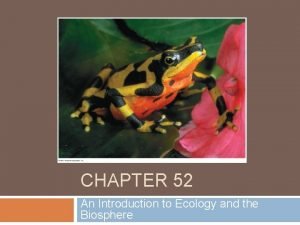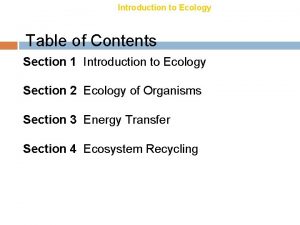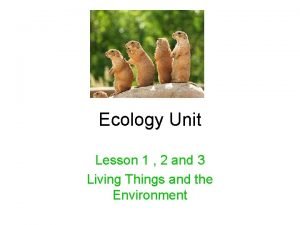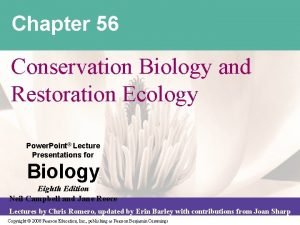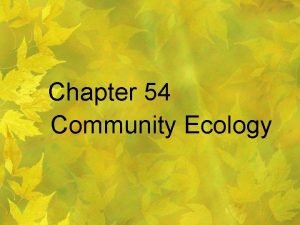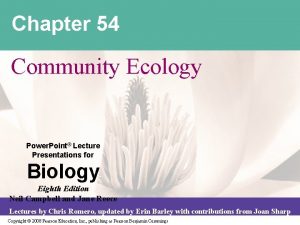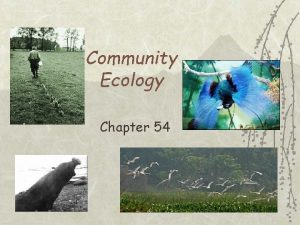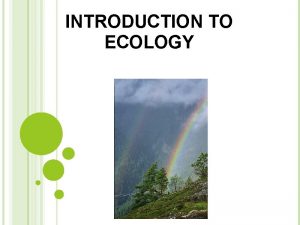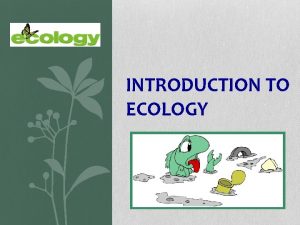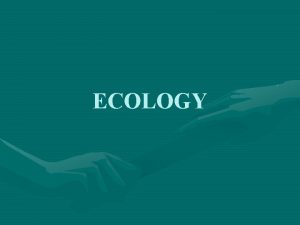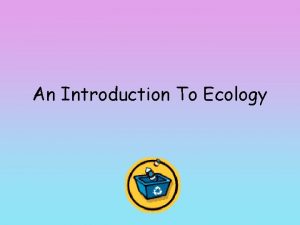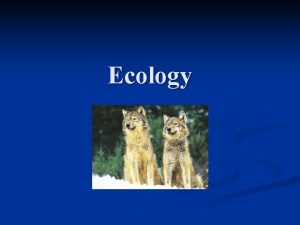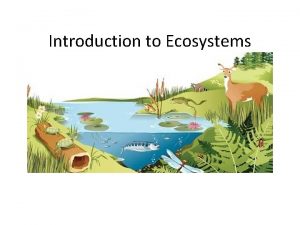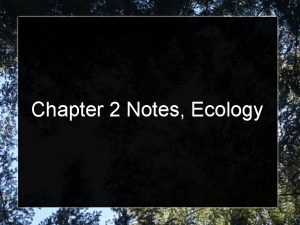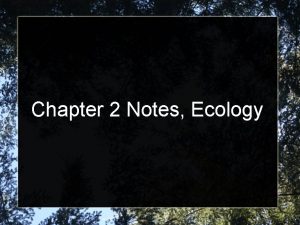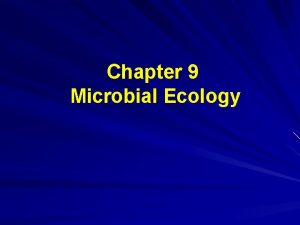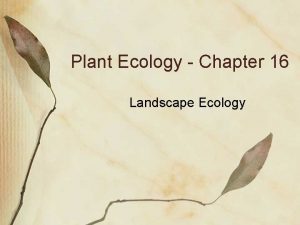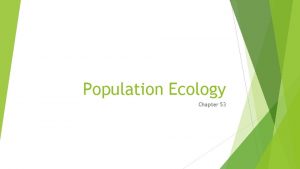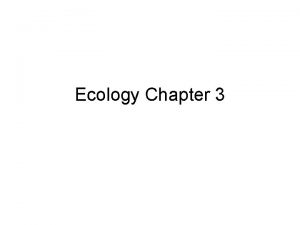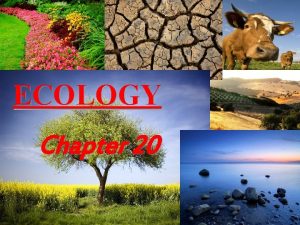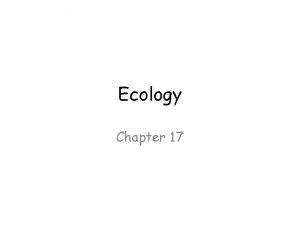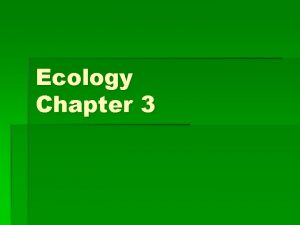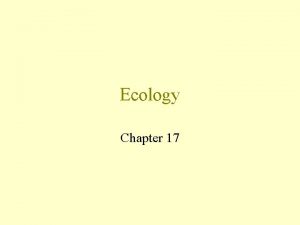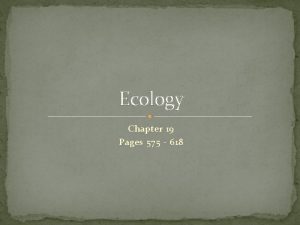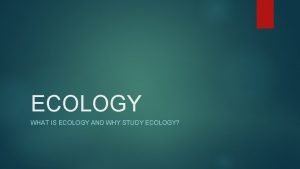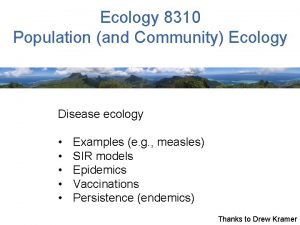CHAPTER 52 An Introduction to Ecology and the






































- Slides: 38

CHAPTER 52 An Introduction to Ecology and the Biosphere

Ecology The study of relationships (interactions) between organisms and their environment.


You Must Know The role of biotic and abiotic factors in the formation of biomes. Major terrestrial and aquatic biomes and their characteristics.

Ecology: the scientific study of the interactions between organisms and the environment The ecological study of species involves biotic and abiotic influences. Biotic factors – the living factors in an organisms environment Ex – plants, animals, bacteria Abiotic factors – nonliving factors in an organisms environment Example – temperature, air, water, light, soil, p. H Organisms are adapted to surviving in their particular natural environment; if they move to another location with different biotic or abiotic factors, they might die if they

Levels of Ecological To. Organization study relationships within the biosphere, ecologists have organized it into smaller pieces. The levels are: 1. Organism (a single individual – one fish, for example) 2. Population (when organisms of a single species share the same geographic location at the same time) 3. Community (a group of populations that interact and occupy the same space at the same time) 4. Ecosystem (a biological community plus all of the abiotic factors that affect it) ex – trees plus water and soil 1. Biome (a large group of ecosystems that share the same climate and have similar communities) Ex – marine or desert biomes

Because, big elephants cry pretty often

Biomes: major types of ecosystems that occupy very broad geographic regions (can be made of many ecosystems)

Climate and elevation determine biomes Figure 34. 7 C Figure 34. 12

Climate: long-term prevailing weather conditions in a particular area Climate = temperature + precipitation + sunlight + wind Macroclimate vs. microclimate: Macro: work at seasonal, regional or local level Micro: small-scale environmental variation (eg. under a log) Climate change: some species may not survive shifting ranges

Climograph: plot of temperature & precipitation in a particular region

Global Climate Patterns: Sunlight intensity

Global Climate Patterns: Air Circulation & Precipitation Patterns

Global Climate Patterns: Ocean Currents

Global Climate Patterns: Mountains affect rainfall (windward vs. leeward)

Which side of the mountain has more plants? Why?

http: //www. ted. com/talks/greg_asner_ecology_ from_the_air#t-205972

Terrestrial Biomes

Desert – dry, sparse vegetation, temps fluctuate day/night

Temperate Grassland – hot summer, cold winters and moderate year-round moisture

Savanna – grasslands with scattered trees; seasonal rain and temps.

Tundra – found in extremely cold climates and high elevations/latitudes with low precipitation; layer of permafrost

Chaparral – hot, dry summers and cool, moist winters. Woody shrubs and herbs are drought resistant; coastal and Mediterranean climates

Tropical Forest (dry vs. rain)

Northern Coniferous Forest (Borreal/taiga) – long, cold winters with short summers and moderate moisture

Temperate Broadleaf/Deciduous Forest – hot summers, cold winters with moderate precip.

Temperate Rain Forest – lots of precip and mild temps (conifers with moss)

Aquatic Biomes

Lakes – inland bodies of standing water (usually fresh water)

Wetlands – lowland areas saturated with water

Streams & Rivers

Estuaries transition zone where rivers meet the sea (usually brackish water)

Intertidal Zones – above water at low tide, and under water at high tide

Oceanic Pelagic Zone (Open Water)

Coral Reefs – made from skeletons of coral polyps (found in warm, shallow oceans)

Marine Benthic Zone

Assignment Your group will be assigned a biome. Using a LARGE white board, you will need to have the following info about your biome: General info (location, characteristics, climate) Pictures (drawings) Examples of plants and animals that live in the area, biotic and abiotic factors) You will then move around the room WITH YOUR GROUP to fill in your graphic Tundra Biome Desert Biome Taiga Biome Tropical Rainforest Biome Chaparral Biome Coral Reef Biome Freshwater Biome Grassland Biome Ocean Biome Savanna Biome Temperate Deciduous Forest Biome Wetland Biome

Ch. 52 Warm-Up 1. 2. 3. Name examples of biotic and abiotic factors in the environment surrounding OHS. Which biomes can be found in Utah? Define the following terms (either on separate notecards or vocab list page): population community ecosystem biosphere
 Chapter 52: an introduction to ecology and the biosphere
Chapter 52: an introduction to ecology and the biosphere Chapter 52 an introduction to ecology and the biosphere
Chapter 52 an introduction to ecology and the biosphere Chapter 4 section 1 population dynamics
Chapter 4 section 1 population dynamics Section 18-1 introduction to ecology worksheet answers
Section 18-1 introduction to ecology worksheet answers Lesson 1 introduction to ecology answer key
Lesson 1 introduction to ecology answer key Chapter 56 conservation biology and restoration ecology
Chapter 56 conservation biology and restoration ecology Phosphorus cycle pearson education
Phosphorus cycle pearson education 5 evolution and community ecology
5 evolution and community ecology Chapter 55 ecosystems and restoration ecology
Chapter 55 ecosystems and restoration ecology Chapter 5 evolution and community ecology
Chapter 5 evolution and community ecology Chapter 5 evolution and community ecology
Chapter 5 evolution and community ecology Chapter 3 section 1 community ecology answer key
Chapter 3 section 1 community ecology answer key Chapter 54: community ecology answer key
Chapter 54: community ecology answer key Chapter 53 population ecology
Chapter 53 population ecology Chapter 36 population ecology
Chapter 36 population ecology Chapter 2 principles of ecology
Chapter 2 principles of ecology Chapter 2 section 3 cycling of matter answer key
Chapter 2 section 3 cycling of matter answer key Chapter 2 principles of ecology answer key
Chapter 2 principles of ecology answer key Chapter 4 population ecology answer key
Chapter 4 population ecology answer key Biological disturbance
Biological disturbance Chapter 53 population ecology
Chapter 53 population ecology Section 1 population dynamics answer key
Section 1 population dynamics answer key Principles of ecology chapter 2 section 1 answer key
Principles of ecology chapter 2 section 1 answer key Chapter 4 section 2 human population answer key
Chapter 4 section 2 human population answer key Chapter 53 population ecology
Chapter 53 population ecology Chapter 54 community ecology
Chapter 54 community ecology Hình ảnh bộ gõ cơ thể búng tay
Hình ảnh bộ gõ cơ thể búng tay Lp html
Lp html Bổ thể
Bổ thể Tỉ lệ cơ thể trẻ em
Tỉ lệ cơ thể trẻ em Gấu đi như thế nào
Gấu đi như thế nào Glasgow thang điểm
Glasgow thang điểm Hát lên người ơi
Hát lên người ơi Các môn thể thao bắt đầu bằng tiếng nhảy
Các môn thể thao bắt đầu bằng tiếng nhảy Thế nào là hệ số cao nhất
Thế nào là hệ số cao nhất Các châu lục và đại dương trên thế giới
Các châu lục và đại dương trên thế giới Cong thức tính động năng
Cong thức tính động năng Trời xanh đây là của chúng ta thể thơ
Trời xanh đây là của chúng ta thể thơ Mật thư tọa độ 5x5
Mật thư tọa độ 5x5

